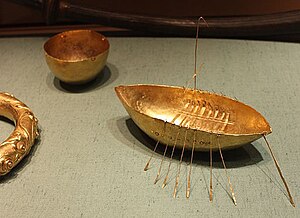Broighter Gold

The boat, bowl, and part of the torc
|
|
| Material | Gold |
|---|---|
| Period/culture | 1st century |
| Discovered | 1896, near Limavady, Northern Ireland, by Tom Nicholl and James Morrow |
| Present location | National Museum of Ireland |
The Broighter Gold or more correctly, the Broighter Hoard, is a hoard of gold artefacts from the Iron Age of the 1st century BC that were found in 1896 by Tom Nicholl and James Morrow on farmland near Limavady, in the north of Ireland (now Northern Ireland). The hoard includes a 7-inch-long (18 cm) gold boat, a gold torc and bowl and some other jewellery. A design from the hoard has been used as an image on the 1996 issue of the Northern Ireland British one-pound coins and the gold ship featured in a design on the last Irish one-pound coins. The Broighter Collar and Broighter Ship also featured on definitive postage stamps of Ireland from 1990–1995. The National Museum of Ireland, who now hold the hoard, describe the torc as the "finest example of Irish La Tène goldworking". Replicas of the collection are kept at the Ulster Museum in Belfast.
The hoard was found near Lough Foyle in a field in the townland of Broighter (Irish: Brú Íochtair, meaning "lower fort") 2 km northwest of Limavady in County Londonderry. It was discovered by Thomas Nicholl and James Morrow while working as ploughmen for Joseph L. Gibson in February 1896. They found the hoard whilst double ploughing. That means that one plough would follow the other to gain extra depth. It was estimated that the finds were buried 14 inches (36 cm) deep and were in close proximity to each other.
...
Wikipedia
